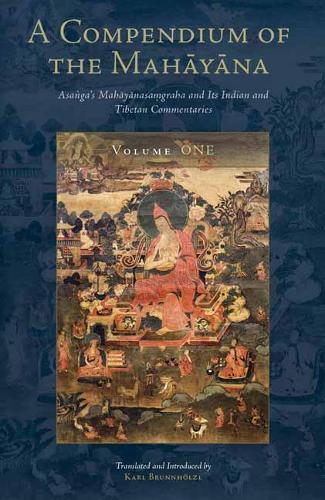
A Compendium of the Mahayana: Asanga's Mahayanasamgraha and Its Indian and Tibetan Commentaries
(Hardback)
Publishing Details
A Compendium of the Mahayana: Asanga's Mahayanasamgraha and Its Indian and Tibetan Commentaries
By (Author) Asanga Asanga
By (author) Karl Brunnholzl
Shambhala Publications Inc
Snow Lion Publications
5th February 2019
25th January 2019
United States
Classifications
Physical Properties
Hardback
1872
Width 152mm, Height 229mm
Description
The first complete English translation of Asaga's Mahayanasagraha, the most important and comprehensive Indian Yogacara text, and all its available Indian commentaries. The first complete English translation of Asanga's Mahayanasamgraha, the most important and comprehensive Indian Yogacara text, and all its available Indian commentaries. Winner of the Khyentse Foundation Prize for Outstanding Translation. TheMahayanasamgraha, published here with its Indian and Tibetan commentaries in three volumes, presents virtually everything anybody might want to know about the Yogacara School of mahayana Buddhism. It discusses in detail the nature and operation of the eight kinds of consciousness, the often-misunderstood notion of "mind only" (cittamatra), dependent origination, the cultivation of the path and its fruition in terms of the four wisdoms, and the three bodies (kayas) of a buddha. Volume 1 presents the translation of theMahayanasamgrahaalong with a commentary by Vasubandhu. The introduction gives an overview of the text and its Indian and Tibetan commentaries, and explains in detail two crucial elements of the Yogacara view- the alaya-consciousness and the afflicted mind (klistamanas). Volume 2 presents translations of the commentary by Asvabhava and an anonymous Indian commentary on the first chapter of the text. These translations are supplemented in the endnotes by excerpts from Tibetan commentaries and related passages in other Indian and Chinese Yogacara works. Volume 3 includes appendices with excerpts from other Indian and Chinese Yogacara texts and supplementary materials on major Yogacara topics in theMahayanasamgraha.
Reviews
"I am delighted that Karl Brunnhlzls new translation of AsangasMahynasamgrahaand its Indian and Tibetan commentaries is being published. An important text in the Sanskrit Yogcra tradition, theMahynasamgrahaand several of its commentaries were translated into Tibetan. However, it never gained as prominent a position in the Tibetan tradition as it had held in Sanskrit or in the Chinese Buddhist tradition. For this reason, this translation, which contains resources from the Indian, Tibetan, and Chinese traditions, is especially helpful. The inclusion of Chinese materials is particularly valuable as it was in China that the text spread most widely and had the greatest influence. I am delighted that it is now available for students to study and contemplate in English." Khenchen Thrangu Rinpoche, author ofLuminous Clarity
"Mitra Karl Brunnhlzl has devoted many years to the study and practice of a broad spectrum of Buddhist topics and practices. Additionally, Karl has studied extensively under my teacher, the renowned yogi-scholar Khenpo Tsultrim Gyamtso Rinpoche, making him duly qualified to offer this groundbreaking study on the topic of Yogcra. This complete translation of AsangasMahynasamgraha, the first of its kind in the English language, along with a number of its commentaries translated for the first time into any modern language, will be of genuine benefit for practitioners and scholars alike. I am grateful to Karl for this monumental undertaking." Dzogchen Ponlop Rinpoche, author ofRebel Buddha
"It is difficult to overestimate the contribution of this massive work to the study of Indian Yogcra Buddhism. Karl Brunnhlzl not only provides reliable translations of theMahynasamgrahaand its major commentaries, a long-standing desideratum in the field, he also offers twenty substantive appendices that illuminate difficult issues in Yogcra theory, such as thelayavijnaand its seeds (bja), the concept of mere cognizance (vijaptimtra), and evolving treatments of the Three Natures. Even more important is the sustained argument, based on this thorough study of the relevant textual sources, that classical Yogcra didnotpostulate mind or consciousness as a truly existing entity, but rather used its critical analyzes of cognitive construction to explain how delusion arises and is then remedied on the path to awakening. This study thus provides a historically contextualized interpretation of Yogcra that challenges the largely ahistorical doxographical modelsthe received tradition accepted in India, Tibet, and most Western circlesthat have long characterized Yogcra as a form of metaphysical idealism. This work could hardly be more timely. We must applaud Karl Brunnhlzl for once again offering students of mahyna Buddhist thought a treasure trove of crucial texts, cogent interpretations, and focused appendices." William S. Waldron, Professor of Religion, Middlebury College
"BrunnhlzlsA Compendium of the Mahynais a remarkable achievement. More than a splendid translation of theMahynasamgrahaalong with its commentaries and numerous related texts, these volumes serve as a detailed and comprehensive primer on mahyna theory and practice, especially as viewed by Yogcra, one of the two Indian mahyna schools. It is clearly written so that it is accessible to serious novices and practitioners, and rich in details that will satisfy and instruct scholars. TheMahynasamgrahahas been influential in India, East Asia, and Tibet, and now its treasures along with the contexts that help unlock its depths are available in an English edition that will remain the standard work for many years to come." Dan Lusthaus, Research Associate, Harvard University
Author Bio
ASANGA (fourth century C.E.) is recognized as a preeminent luminary of the Buddhist mahayana tradition and one of its greatest philosophical innovators. He is credited with having authored the main texts of the Yogacara canon, which exerted an immense influence not only in the Indian subcontinent but also throughout most of Central and East Asia. KARL BRUNNH LZL was trained as a physician and presently works as a Tibetan translator and Buddhist teacher. He studied Tibetology, Buddhology, and Sanskrit at Hamburg University and Tibetan language and Buddhist philosophy and practice at the Marpa Institute for Translators in Kathmandu. Currently he works as a translator and interpreter for Nalandabodhi and the Nitartha Institute. He is the author and translator of over 10 volumes on Buddhist philosophy.
